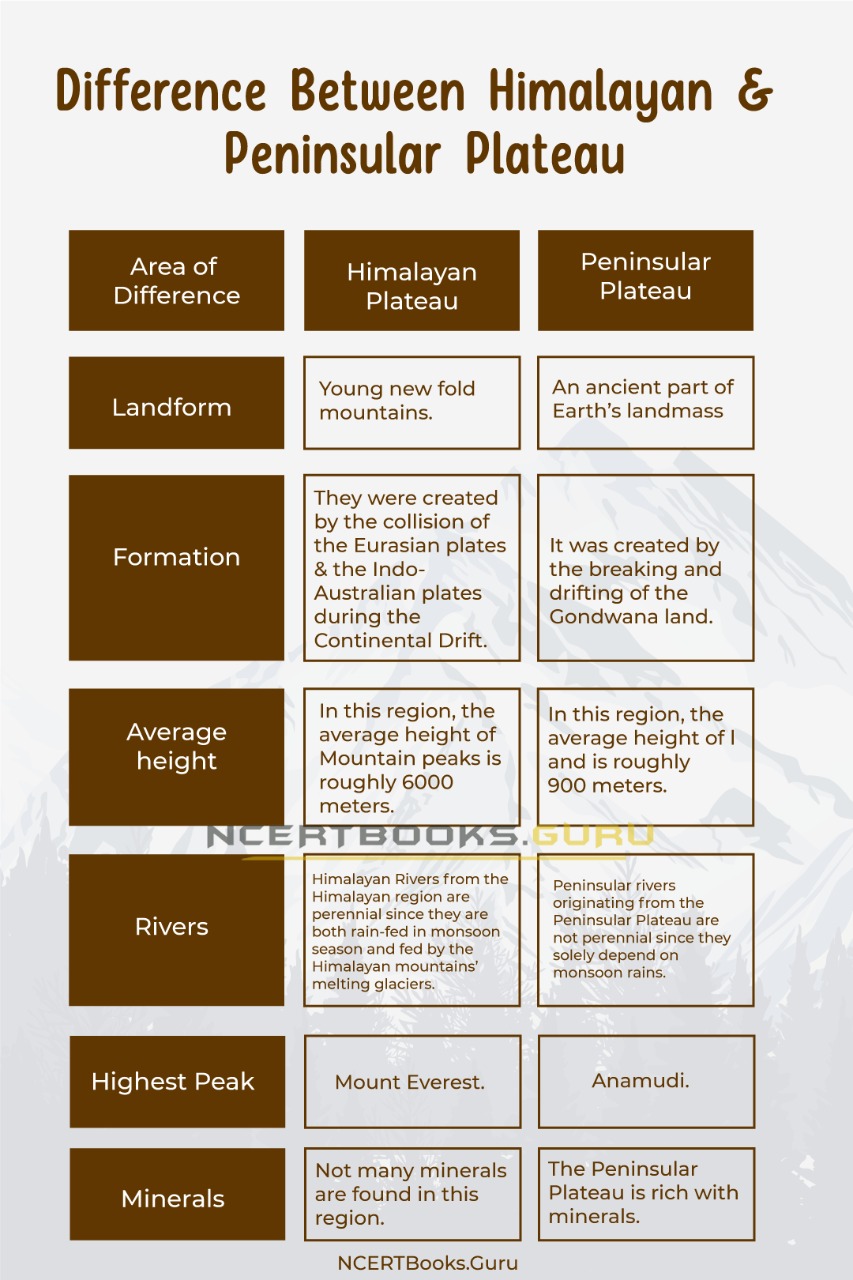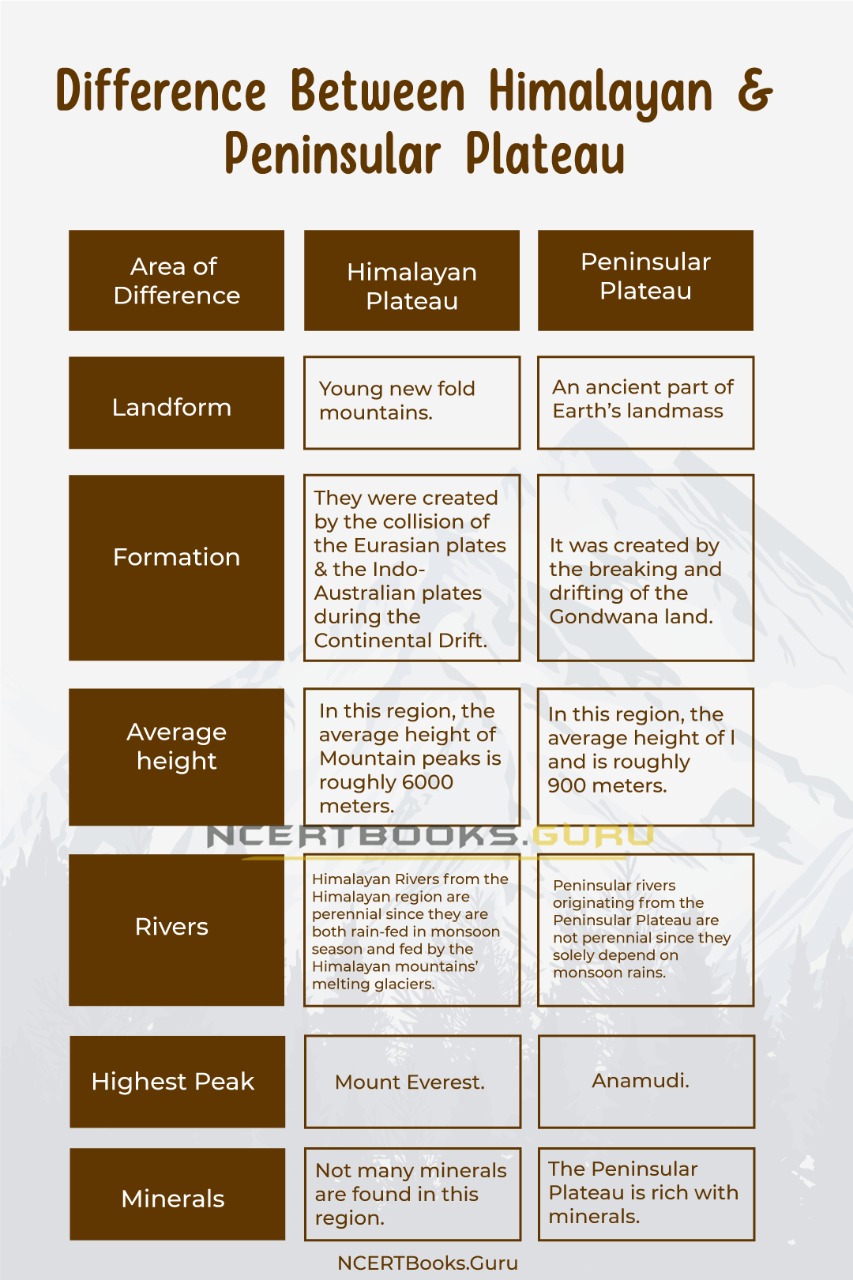Introduction
The difference between the Himalayan and Peninsular Plateau is explained in this article in detail. One of the major differences between these two landscapes is that the Himalayan Plateau or Tibetan Plateau displays a very youthful topography with high summits, deep valleys, and fast-flowing glacial rivers compared to the peninsular plateau which consists of igneous and metamorphic rocks along with small hills and wide valleys.
You can also find differences between articles on various topics that you need to know. Just tap on the quick link available and get to know the basic differences between them.
What is the Difference Between the Himalayan and Peninsular Plateau?
About Himalayan Plateau
The Tibetan Plateau, or known as the Himalayan Plateau in India, is a vast elevated plateau in South Asia, Central Asia and East Asia. It stretches approximately 1,000 kilometres north to south and 2,500 kilometres east to west.
It is the world’s highest and largest plateau with an average elevation exceeding 14,800 ft and is surrounded by the world’s two highest summits, Mount Everest and K2.
The Tibetan Plateau is referred to as “the Roof of the World”. The Tibetan Plateau tens of thousands of glaciers serve as a “water tower” storing water and maintaining flow. It is sometimes termed the Third Pole as it contains the largest reserve of freshwater outside the poles.
About Peninsular Plateau
Deccan plateau or the Peninsular Plateau covers India’s entire southern peninsula, south of the Narmada River, and its marked centrally by a high triangular tableland. The plateau is bordered on the east and west by the Ghats. Its northern part of it is the Satpura Range.
The average elevation of the Deccan Plateau is about 2,000 feet, sloping generally eastward. The major rivers of this region are—the Godavari, Krishna, and Kaveri (Cauvery). It flows from the Western Ghats eastward to the Bay of Bengal. The climate there is drier than that on the coasts and is arid in places.

Difference Between Himalayan and Peninsular Plateau
| Area of Differentiation | Himalayan Plateau |
Peninsular Plateau |
| Landform | Young new fold mountains. | An ancient part of Earth’s landmass |
| Formation | They were created by the collision of the Eurasian plates and the Indo-Australian plates during the Continental Drift. | It was created by the breaking and drifting of the Gondwana land. |
| Average height | In this region, the average height of Mountain peaks is roughly 6000 meters. | In this region, the average height of land is roughly 900 meters. |
| Rivers | Himalayan Rivers from the Himalayan region are perennial since they are both rain-fed in monsoon season and fed by the Himalayan mountains’ melting glaciers. | Peninsular rivers originating from the Peninsular Plateau are not perennial since they solely depend on monsoon rains. |
| Highest Peak | Mount Everest. | Anamudi. |
| Minerals | Not many minerals are found in this region. | The Peninsular Plateau is rich with minerals. |

Similarities of Himalayan and Peninsular Plateau
- Both the Himalayan and Peninsular land consist of large expanses of the plateau, an area of a highland consisting of flat terrain.
- These regions are drier than their surroundings.
- Both these regions are more than 2000ft above the sea level.
Frequently Asked Questions on Difference Between Himalayan And Peninsular Plateau
Question
What is the highest peak in the Himalayan Plateau region?
Answer:
Mount Everest.
Question
Are the rivers in Peninsular Plateau region perennial rivers?
Answer:
No, the rivers in Peninsular Region are rain-fed and regional.
Question
Which region is colder- the Himalayan or Peninsular region?
Answer:
The Himalayan Plateau region is colder.
